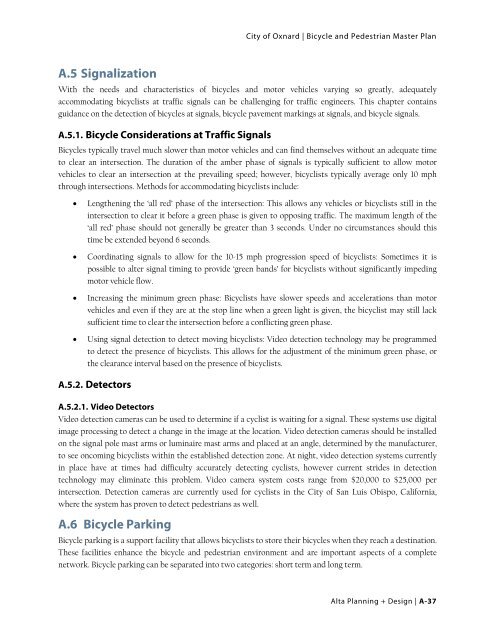City of Oxnard - Bicycle and Pedestrian Master Plan Appendices
City of Oxnard - Bicycle and Pedestrian Master Plan Appendices
City of Oxnard - Bicycle and Pedestrian Master Plan Appendices
Create successful ePaper yourself
Turn your PDF publications into a flip-book with our unique Google optimized e-Paper software.
<strong>City</strong> <strong>of</strong> <strong>Oxnard</strong> | <strong>Bicycle</strong> <strong>and</strong> <strong>Pedestrian</strong> <strong>Master</strong> <strong>Plan</strong><br />
A.5 Signalization<br />
With the needs <strong>and</strong> characteristics <strong>of</strong> bicycles <strong>and</strong> motor vehicles varying so greatly, adequately<br />
accommodating bicyclists at traffic signals can be challenging for traffic engineers. This chapter contains<br />
guidance on the detection <strong>of</strong> bicycles at signals, bicycle pavement markings at signals, <strong>and</strong> bicycle signals.<br />
A.5.1. <strong>Bicycle</strong> Considerations at Traffic Signals<br />
<strong>Bicycle</strong>s typically travel much slower than motor vehicles <strong>and</strong> can find themselves without an adequate time<br />
to clear an intersection. The duration <strong>of</strong> the amber phase <strong>of</strong> signals is typically sufficient to allow motor<br />
vehicles to clear an intersection at the prevailing speed; however, bicyclists typically average only 10 mph<br />
through intersections. Methods for accommodating bicyclists include:<br />
• Lengthening the ‘all red’ phase <strong>of</strong> the intersection: This allows any vehicles or bicyclists still in the<br />
intersection to clear it before a green phase is given to opposing traffic. The maximum length <strong>of</strong> the<br />
‘all red’ phase should not generally be greater than 3 seconds. Under no circumstances should this<br />
time be extended beyond 6 seconds.<br />
• Coordinating signals to allow for the 10-15 mph progression speed <strong>of</strong> bicyclists: Sometimes it is<br />
possible to alter signal timing to provide ‘green b<strong>and</strong>s’ for bicyclists without significantly impeding<br />
motor vehicle flow.<br />
• Increasing the minimum green phase: Bicyclists have slower speeds <strong>and</strong> accelerations than motor<br />
vehicles <strong>and</strong> even if they are at the stop line when a green light is given, the bicyclist may still lack<br />
sufficient time to clear the intersection before a conflicting green phase.<br />
• Using signal detection to detect moving bicyclists: Video detection technology may be programmed<br />
to detect the presence <strong>of</strong> bicyclists. This allows for the adjustment <strong>of</strong> the minimum green phase, or<br />
the clearance interval based on the presence <strong>of</strong> bicyclists.<br />
A.5.2. Detectors<br />
A.5.2.1. Video Detectors<br />
Video detection cameras can be used to determine if a cyclist is waiting for a signal. These systems use digital<br />
image processing to detect a change in the image at the location. Video detection cameras should be installed<br />
on the signal pole mast arms or luminaire mast arms <strong>and</strong> placed at an angle, determined by the manufacturer,<br />
to see oncoming bicyclists within the established detection zone. At night, video detection systems currently<br />
in place have at times had difficulty accurately detecting cyclists, however current strides in detection<br />
technology may eliminate this problem. Video camera system costs range from $20,000 to $25,000 per<br />
intersection. Detection cameras are currently used for cyclists in the <strong>City</strong> <strong>of</strong> San Luis Obispo, California,<br />
where the system has proven to detect pedestrians as well.<br />
A.6 <strong>Bicycle</strong> Parking<br />
<strong>Bicycle</strong> parking is a support facility that allows bicyclists to store their bicycles when they reach a destination.<br />
These facilities enhance the bicycle <strong>and</strong> pedestrian environment <strong>and</strong> are important aspects <strong>of</strong> a complete<br />
network. <strong>Bicycle</strong> parking can be separated into two categories: short term <strong>and</strong> long term.<br />
Alta <strong>Plan</strong>ning + Design | A-37
















